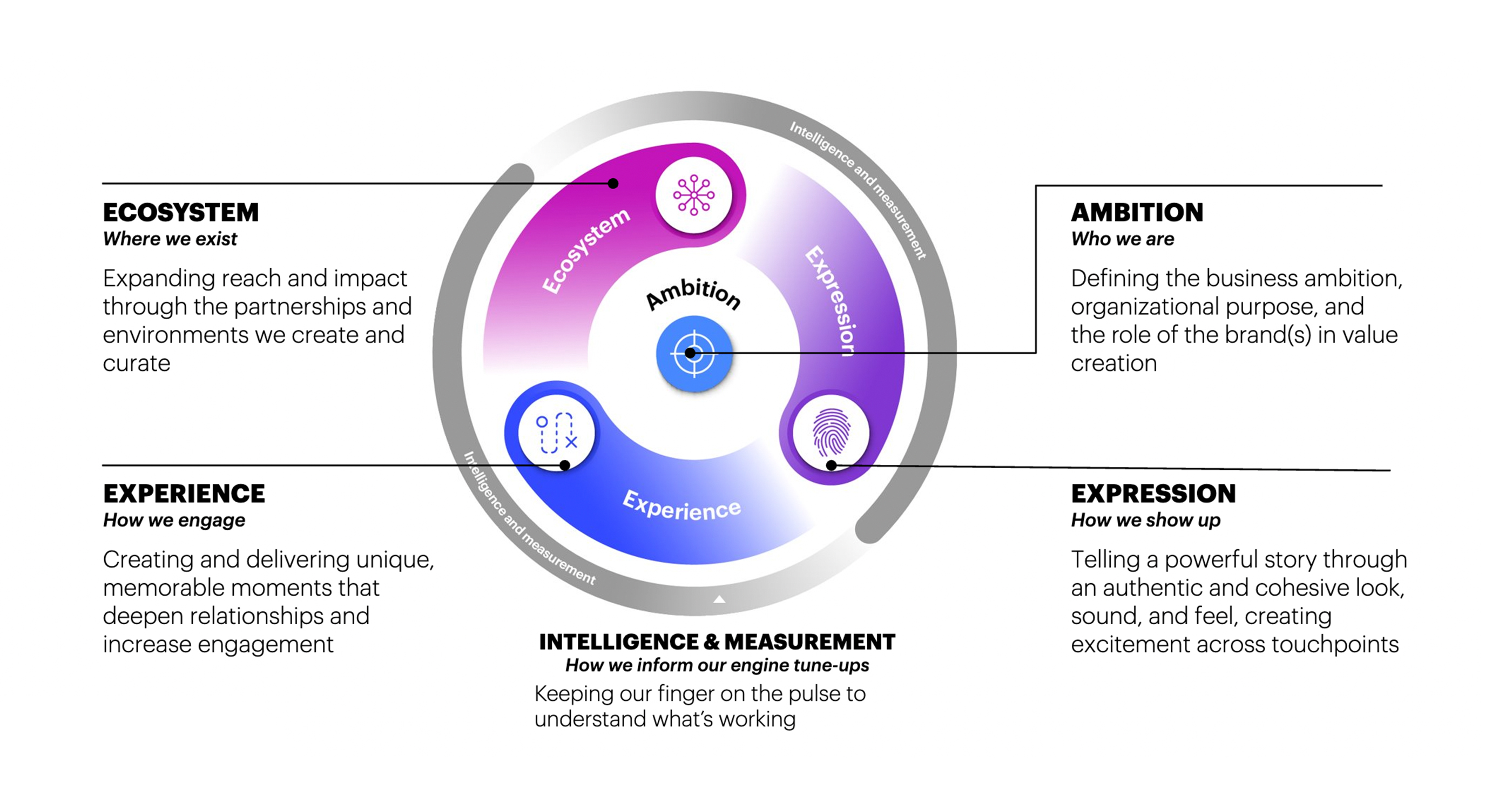BLOG
Powering Sustainable Growth with Your Brand Engine
The most relevant brands require ongoing maintenance. Prophet’s Brand Engine Model outlines the five levers needed to drive growth.
During a recent assignment for a global automaker, a non-marketer on the client team pulled me aside. A little embarrassed, he asked, “What even is a brand and why does it matter?” Our side conversation spiraled. Is an NFT a brand? A religion? How about IP? Heck, can a person really be a brand? It took me a minute, but I finally got his deeper question: How does brand building lead to growth?
It’s a question we all – consultants and clients alike – should consider more often. We know brands are valuable, if intangible, assets. While the value of a brand fluctuates by industry, there is no question that it has value. Brand value is calculated in the accounting of every merger and acquisition. While estimating these values is an industry unto itself, we know value derives from many elements – from the organization’s highest leaders to consumers’ interactions and experiences. Brands are valuable because they are a short-cut, a promise– representing a set of functional and emotional expectations. The value of the brand reflects complex understandings, strategies, symbols, and beliefs.
Most companies understand brand value needs to be nurtured and protected. They are aware of what’s at risk. For most successful organizations, however, a brand is not just an asset. It’s also an engine of growth, powering the next horizon of success.
For the past eight years, Prophet has surveyed thousands of consumers in our annual brand relevance study to understand which brands are most relevant to their lives. Our research has shown that the most relevant brands, have found ways to build customer loyalty, and ultimately drive more growth. The top-performing brands in our study, have outperformed the S&P 500 by 201% in the last five years.
To quantify how brands build relevance, we used this research and our years of experience building brands to develop a Brand Engine Model which is powered by five critical components. It’s clear that brand is a critical driver of growth, and all organizations should be constantly building, nurturing and refining their brands or risk losing relevance with their customers. While marketing is often responsible for owning brand, it should not be overlooked across the C-suite as a crucial component towards supporting the business reach its revenue goals.

Prophet’s Brand Engine Model
(See full-sized version in your browser)
Building a Powerful Brand Engine
Ambition: Who are we?
All engines start with a spark. For brands, that spark is ambition, defining the organizational purpose and role of the brand in value creation. Patagonia’s inimitable “Earth is our only shareholder” commitment sets a high bar. However, businesses as diverse as Nike, USAA and LEGO answer that question in ways that make people’s hearts soar. Every brand must have a well-defined purpose that sets it apart and gives all its stakeholders – customers, employees and shareholders – something to believe.
Ambition supplies the instructions required to set the engine in motion. Without it, wheels spin, and brands lurch along, but with no velocity.
Remember my client’s question about whether a person can be a brand? If that were true, that person would clarify ambition by asking, “What do I want to be when I grow up?”
To set the agenda for ambition, companies need to ask:
- What is our core belief that guides and inspires our actions?
- What needs are we serving in people’s lives?
- What business are we in and how might the brand allow the business to execute on our corporate strategy?
Ecosystem: Where do we exist?
The Ecosystem does more than define a frame of reference. It requires a deep understanding of how the brand fits into people’s lives. For both B2B and B2C brands, the ecosystem helps define the competitive landscape. Having a well-articulated ecosystem not only creates a sandbox for brands to own and operate, it also provides an opportunity for strategic and innovative partnerships. Whether it’s Peloton moving into Hilton properties, Calm app paying mental-health fines for tennis players, Gucci partnering with Oura rings or a Spotify playlist following passengers into an Uber, the opportunity for productive partnerships often leads to new revenue streams.
Ecosystems also function as powerful collaborative areas for companies to build on their employer brand, engaging employees in ways that keep them curious. Google, for example, has famously encouraged its people to devote 20% of their work time to projects in their personal areas of interest. That way, the brand constantly re-invites employees into its incubator-esque way of thinking.
To set the context for ecosystem, companies need to ask:
- What is the context in which a consumer experiences a brand (e.g., depending on pre-existing biases, situational relevance, or physical environment)?
- How does the brand(s) fit into consumers’ lives, relative to the other brands that they regularly interact with?
- How should we organize our own architecture and relationships to optimize navigation, understanding, and brand equity building?
- What brands do we want to be associated with (e.g., deliberate partnerships or inadvertent association)?
Expression: How do we show up?
To many, this component is classic branding. It tells a powerful story through an authentic, cohesive look, sound and feel. It is a way to create excitement across touchpoints. And it includes all the more common things associated with branding, from logo to commercial to content. Of all the engine components, it is often the most closely bound to strategy. While Apple and BMW do many things right, they are routinely flawless in this dimension.
While this component feels classic, its importance should not be overlooked. When heritage brands refresh their visual identities it’s big news. Consumers and employees find comfort and build attachments to brands they feel deep loyalty to. From UGG to JetBlue, we’ve seen brands maneuver expression both expertly and not so expertly.
To align a path forward for expression, companies need to ask:
- How do we use our visual identity, voice, messaging strategy, and other signature stories to tap into the underlying human truths/emotions from our Ambition?
- How might we use our visual identity, voice & messaging, and other stories to drive awareness, interest, and engagement?
- How can, and should, we feel and sound distinct in-market to stand out from competitive brands and drive an ownable position?
Experience: How do we engage?
At every touchpoint, even if it’s beyond a company’s control, people form a perception of the brand. Experiences can deliver unique moments, using those perceptions to deepen relationships.
Companies have come a long way in acknowledging the importance of experience but continue to under-invest in it. That neglect shows. One major study shows customer experience is plummeting, falling 20% last year. And one in five companies says they plan to eliminate CX.
The best brands constantly think of both the owned and the un-owned touchpoints, curing problems and allowing the brand to flourish. UGG, for example, leans hard on diverse influencers with activations at music and film festivals. Lululemon creates thousands of store-as-community-hub events, partners with meditation organizations and hosts women-friendly road races. Jeep owners love the tradition of the `Jeep Wave,’ enthusiastically calculating their place in the ranking hierarchy before flashing the sign.
To set the stage for experience, companies need to ask:
- How should the experiences that we design make our customers or users feel (e.g., de-cluttered, inspired, appreciated), in a way that ties back to our core human truths defined in Ambition?
- How can we make the lives of our customers/users easier?
- How might our set of experiences serve as a revenue platform through efficient, digital-first channels?
- How might these service channels drive long-term loyalty and stickiness?
Intelligence and Measurement: Are we moving in the right direction?
More than ever, marketers are being asked to prove their value and show business results. Applying intelligence and measurement allows for demonstrating success but it also enables quick optimizations to deliver better outcomes. It keeps the finger on the pulse of audiences. Virtually all marketers know this, yet many don’t yet have the tools and capabilities in place to harness their data to maximize output.
Companies that spend the most on measurement and insights are among the world’s fastest-growing. Dove, for example, owned by Unilever, never stops mining its years of social-media success for insights about core users. Its latest hit is the #TurnYourBack campaign, encouraging people to shun TikTok’s unrealistic beauty standards, earning close to 800 million impressions.
And McDonald’s extensive investments in ongoing customer research shape every menu tweak and new promotion, following people’s fast-changing perspectives on everything from which beef is healthiest, plant-based alternatives and Grimace’s return to glory.
To set the limits for intelligence and measurement, companies need to ask:
- What equities does our brand have with audiences, and how have these shifted?
- How well are we serving their emotional and functional needs?
- How are different parts of our business performing and how might our brand better serve our engagement and customers?
Ultimately, the quality of execution across all five components drives brand value, transformation and growth. But no two engines are the same. Some brands might invest more resources in expression, others in experience. Pepsi isn’t the same as Pinterest. But a carefully calibrated brand engine can change gears as context shifts and unforeseen events happen. And with equilibrium, brands grow into de-risked, agile engines of growth.
FINAL THOUGHTS
Every brand is an engine. When companies are willing to turn them on, fine-tuning and optimizing as they go, they move into the fast lane. They gain traction, passing competitors. They become an explosive source of uncommon growth and transformation.
To learn more about creating relevant brands that drive growth, contact our team today.

